Fossil Lab Monthly Open House
October 9, 2024
Looking to visit the Fossil Lab?
We will be having open houses in the fall on the second Thursday of the month from 3:30 - 5 pm.
Upcoming dates: October 9th and November 13th
Open houses will be paused over the winter and resume in early spring 2026.
Join us to check out real fossil bones and dinosaurs skeletons and reconstructions.
Paul Sereno’s Fossil Lab moves to Washington Park
May 1, 2024
Paul Sereno’s Fossil Lab moves to Washington Park
Looking to visit?
We will be having open houses in the fall on the second Thursday of the month from 3:30 - 5 pm.
Upcoming dates: October 9th and November 13th
Open houses will be paused over the winter and resume in early spring 2026.

The 6,000 square foot facility will feature fossil preparation space, multipurpose areas for community programs, and tons of specimens collected from Sereno’s worldwide expeditions.

Soon, South Side residents won’t have to travel to the Field Museum to see a Tyrannosaurus rex skeleton—there will be one in their own backyard. Paleontologist Paul Sereno’s Fossil Lab at the University of Chicago is moving to the center of the Washington Park neighborhood on South Wabash Avenue, just off Garfield Boulevard. The 6,000 square foot facility will open May 2, 2024, transforming a 1921 wood-beam warehouse into a fossil wonderland.

“It’s a dream lab for paleontologists and archaeologists,” said Sereno, who is a Professor of Organismal Biology and Anatomy at UChicago. “It will be one of the largest labs of its kind in the world, one designed for high throughput of massive dinosaur skeletons.”
In addition to housing Sereno’s fossil specimens, the new lab is designed to welcome the neighborhood as well. Featuring a colorful dinosaur mural on the front of the building, the glass walls of the Prep Lab and the mobile work desks and projector screen of the central Learning Room aren’t just for scientists and research. Sereno will invite community groups, teachers, and students to tour the facility and use its spacious rooms for meetings, service training, in-school visits, and after-school programs.

“Washington Park is getting its own T-rex skeleton,” said Sereno, who is readying the new lab to receive tons of new dinosaurs he and his team collected in the Sahara Desert on an excursion in the fall of 2022. “This is a game-changer for any kid in the neighborhood that dreamed of getting within arm’s reach of dinosaur bones.”
Washington Park Resident Advocacy Council President Cecilia Butler says neighborhood residents are excited to get up close with fossils in the new lab. “It’s wonderful to be part of the work and see and feel things like we see on science shows on TV,” Butler said. “Paul is giving us an opportunity to be hands on and everyone in the community is extremely excited.”

The Prep Lab in the new facility is what Sereno calls his “bone makerspace,” featuring an array of tools and microscopes for cleaning, stabilizing, and protecting fossils. Fossil technicians with decades of experience will guide college students, volunteers, and high school interns in their work on unique fossils collected by Sereno’s team around the world. It’s all hands-on work with bones, fossil and recent, to recompose skulls and skeletons.
The lab’s Learning Room is a large multi-purpose resource room for researchers, college students, and teens in after-school programs. It can also host community meetings or even film screenings, with kitchenette counters for coffee and popcorn. Its large projector screen, marker boards, movable workstations, and 3D printers facilitate interactive learning. As a final dramatic touch, skeletons of living birds, mammals, and alligators hang from the ceilings as final projects in one of Sereno’s college classes.

The facility will ramp up what Sereno can achieve in research output. It’s arranged on one floor with a wide freight entrance, meaning staff can move large specimens with ample workspace. “Everything will be more efficient in the new space,” Sereno said. He has a backlog of fossils stored in field jackets in another warehouse, a haul he estimates at more than 50 tons.
Rev. Jesse Knox III, Senior Minister at the Church of the Good Shepherd and Executive Director of the Good Shepherd Community Services Organization in Washington Park, said the timing for the lab is a perfect complement to other new developments on the South Side. “Bringing amenities to the whole area is crucial to have a vibrant community,” he said. “It signals the beginning that other good things are coming to the neighborhood. Introducing young kids to get excited about science in a hands-on, positive environment has been needed for a long time. Excitement is an understatement.”
Contributing to the neighborhood scene is equally exciting to Sereno and his team. “For teens, the possibilities are endless. We’ll have a Jurassic Park show, surrounded by gigantic bones, and talk dinosaur science,” Sereno said. “I’m thrilled to operate a science lab in a neighborhood. It’s just off the main drag and soon a recognized landmark when the dinosaurs arrive.”

Can 50 tons of fossils help hatch paleontology in Niger?
March 7, 2024
Goats, cows, and pedestrians wander by the two unassuming shipping containers along a street in Niger’s riverside capital without a second thought. Continue Reading.

Diving Dinosaurs? New paper out
March 6, 2024
Study by UChicago paleontologists and colleagues uncovers major issues with
earlier suggestions that the sail-backed mega-predator Spinosaurus pursued
prey underwater. PDF

New Dinosaurs of the Sahara Exhibit!
May 25, 2023Cleveland Great Lakes Science Center
Get a whole new dinosaur experience with Dinosaurs of the Sahara, the lost world of African dinosaurs, debuting for the first time at the Cleveland Great Lakes Science Center on Friday May 26 and running through Monday September 4. Dinosaurs of the Sahara brings the unique world of African dinosaurs to life with original fossils from the Sahara, one-of-a- kind mounted skeletons and flesh models, and a show-stopping giant 32-foot rearing long-necked Jobaria skeleton! Get to touch real fossils, including a SuperCroc skull, and relive the excitement and adventure of Paul Sereno’s recent ground-breaking Saharan expeditions with live footage and an interactive dinosaur dig site. Get an up close look at Africa’s greatest predators, including spinosaurs and Africa’s T-rex-sized predator, Carcharodontosaurus. Meet some of the most bizarre plant eating dinosaurs imaginable, like Nigersaurus, nicknamed the Mesozoic cow!
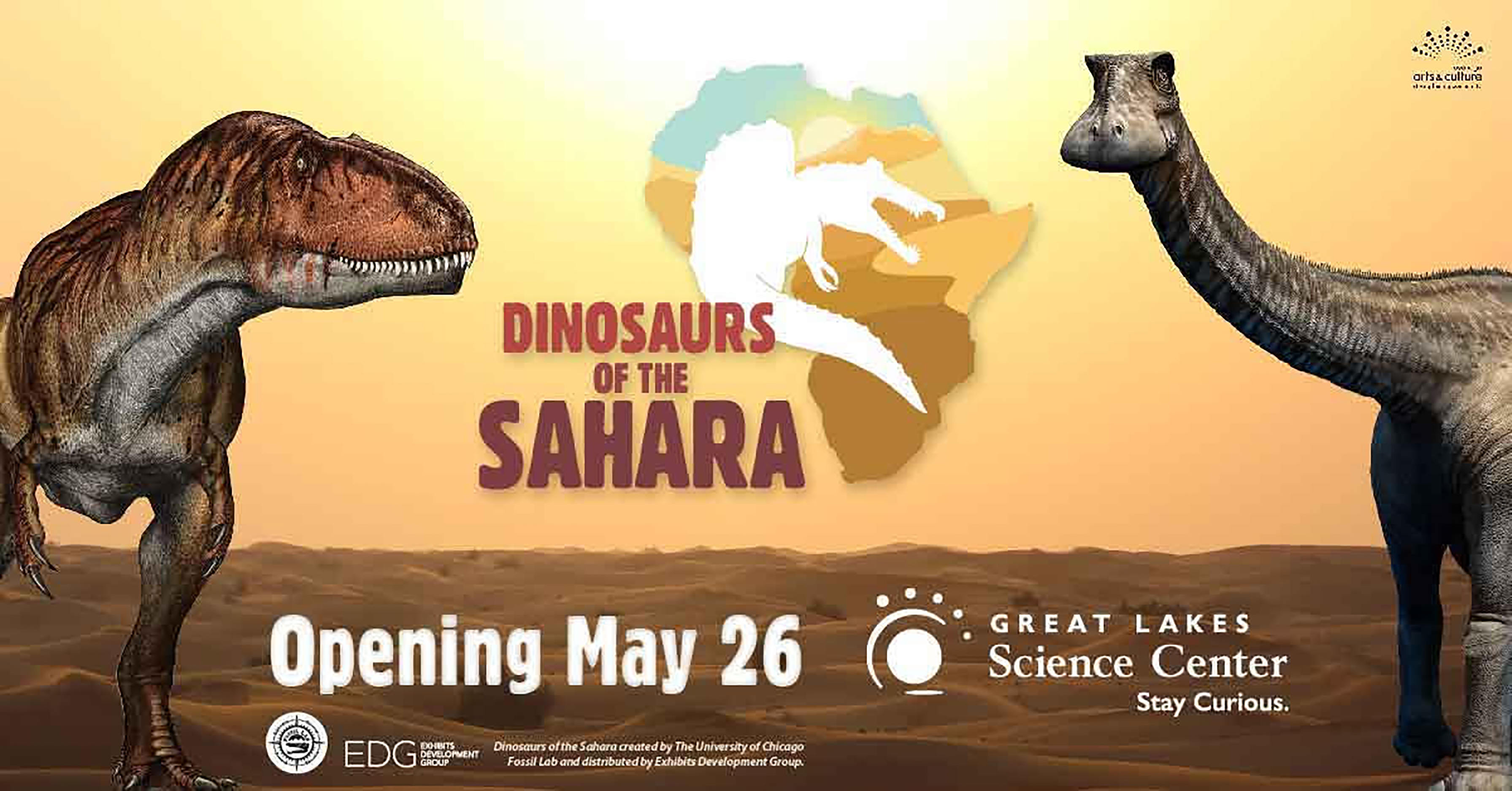
Dinosaurs of the Sahara, the lost world of African dinosaurs
Looking back on a trip to a land of dinosaurs, and all we gained
March 27, 2023
New dinosaurs by the dozen fill two large shipping containers poised to depart Niger for Africa’s coast and then travel by ship across the Atlantic destined for my Fossil Lab at the University of Chicago, where a process of cleaning and recomposing bones over the coming years will unveil a menagerie of new species. The fossils were collected during a fall 2022 expedition and later will return to Niger, home to the richest fossil beds in Africa.
Keep reading at Chicago Tribune.

A rendering of the proposed Musée du Désert Vivant (Museum of the Living Desert) for the city of Agadez in Niger. (Stantec / HANDOUT)

A skeleton of the dinosaur Suchomimus is displayed during a ceremony at the La Flamme de la Paix (Flame of Peace), a monument at a remote desert locale outside the city of Agadez in Niger.
Discovering Dinosaurs Adrift in Seas of Sand
January 5, 2023
JENGUEBI, NIGER – Seas of sand form the core of the Sahara, the world’s largest desert. Our expedition caravan wound slowly between dunes, probing for terrain hard enough to get us to our end goal —windswept rock with fossils from the youngest part of the dinosaur era on Africa some 90 million years ago. Exposed as isolated patches, the target areas resemble an oceanic island chain, each patch decreasing in size until disappearing altogether under the sand seas.
Read more in the Chicago Tribune.
Or Read PDF.

With few clouds and not a drop of rain, the rising and setting of the sun and moon are spectacular on a Saharan expedition. Photo courtesy of Paul Sereno.

Atop his Honda CGL 125, guide Abdoul Nassar scouts the desert for fossils traveling 100 miles on little over a gallon of gas. Photo courtesy of Paul Sereno.

Holding battery powered drill-breakers in plaster-covered hands, Spanish team members Alvaro Simarro and Ana Lázaro break to pose during the excavation of a dinosaur skeleton. Photo courtesy of Filippo Bertozzo.

The sabre-shaped tooth of a T-rex-sized predatory dinosaur fills the hand of discoverer Alvaro Simarro, a Spanish student studying the evolution of dinosaur teeth. Photo courtesy of Alvaro Simarro.

Tons of fossils in field jackets compete for space with water tanks aboard the team’s truck for the return trip to Agadez. Photo courtesy of Paul Sereno.

Nearly as perfect as the day it was covered 110 million years ago, a juvenile skull of SuperCroc is already nearly the size of expedition leader, Paul Sereno. Photo courtesy of Paul Sereno.
Spinosaurus is not an aquatic dinosaur
November 30, 2022
The hunting habits of Spinosaurus aegyptiacus, the largest known predatory dinosaur to roam the Earth, have been subject to intense scientific debate since detailed descriptions of its most complete fossils to date were published in 2014. At the time, Spinosaurus was described as a “semiaquatic” predator that prowled the shoreline of Cretaceous-era rivers, wading into the muddy banks to ambush fish with its massive, crocodilian jaws and interlocking teeth.
Continue reading Was the mega predator Spinosaurus really an underwater hunter?
Read the full eLife paper Spinosaurus is not an aquatic dinosaur.
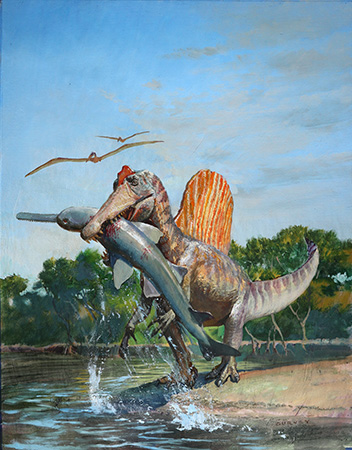
Feeding scene: Its jaws clamping down on a massive sawfish, Spinosaurus at 45 feet in length dominated water's edge along the coasts and inland rivers of Africa during the early Late Cretaceous.
Unearthing Africa’s giants — and an ancient calamity
November 11, 2022
TCHINEKANKARAM, NIGER — One mile long, rising as barren rock no more than 10 feet above a parched plain of patchy grass and thorny acacia, is an area known as Tchinekankaran (chin-kan-karan), or “place of insects” in Tamasheq, the language of Tuareg nomads. True to its name, voracious scorpions, wind spiders and praying mantises dueled under our camp lights, but we came for the sea of fossil bones peeking from rocks nearby.
Keep reading in the Chicago Tribune:
Unearthing Africa’s giants — and an ancient calamity
Or View PDF

Excavating a thigh bone (femur) of the new dinosaur weighing in at around 500 pounds, 'Pako’ (Francesc Gascó, left) and Grace Broderick (right) chip away the rock entombing the largest bone in its skeleton. Photo courtesy of Paul Sereno.

Sketching a fleshed-out version of the new dinosaur ‘Ipod’ in his field book, Spanish paleontologist 'Pako’ (Francesc Gascó) engages his artistic talents during a meal break. Photo courtesy of Paul Sereno.

A subadult (‘teen’) skeleton of the new dinosaur ‘Ipod’ is excavated by Spanish team members (left to right) Noelia Sanchez, Arturo Gamonal and Frenscesc Gascó. Photo courtesy of Paul Sereno.

Excavating a fossil giant, Spanish paleontologist Dan Vidal and Paul Sereno use tools that range from small brushes to jackhammers. Photo courtesy of Keith Ladzinski.

Excavating a fossil giant, Spanish paleontologist Dan Vidal and Paul Sereno use tools that range from small brushes to jackhammers. Photo courtesy of Keith Ladzinski.

Relaxing in a comfortable curve of the just-tipped field jacket surrounding the neck of the new dinosaur ‘Ipod,’ paleontology student Grace Broderick takes a moment to relax in the heat of a Saharan midday. Photo courtesy of Paul Sereno.

The excavation scene of a small skeleton of the long-necked dinosaur dubbed ‘Ipod’ on a parched, rocky plain in Niger.
Exploring Gadoufaoua
October 21, 2022
GADOUFAOUA, NIGER — Petrified tree trunks jut from the desert floor, and fossil jaws and bones of nameless beasts peek out from a barren landscape. Nomad legend describes it as “The place where camels fear to go.” Called Gadoufaoua (Ga-doo-fawa) by French geologists who visited in the 1950s, this 100-mile stretch of the Sahara comprises the richest dinosaur beds on the continent. Just 10,000 years ago, Gadoufaoua was a lush paradise, home to elephants, hippos, crocs, six-foot perch, and an early civilization of people. On lakeside dunes at a place in Gadoufaoua known as Gobero, their small villages thrived on this abundance without ever tilling soil or tending livestock. All that vanished with the water some 5,000 years ago, leaving behind ancient graveyards not far from huge dinosaur fossils from Africa’s much deeper past.
Keep reading in the Chicago Tribune:
Exploring Gadoufaoua, known as 'the place where camels fear to go'
Or View PDF

Riders atop camels and as many cars with supporters weave through the desert in a wild race to the finish, the finale of the Cure Salée festival in InGall.
Photo courtesy of Matt Irving.

Following a trail, three expedition Land Rovers head a vehicle train that numbers 15, counting the armed escort and truck filled with supplies.
Photo courtesy of Matt Irving.

Spotlights allow excavation of a sail of the dinosaur Ouranosaurus in the cool of the night in Gadoufaoua.
Photo courtesy of Matt Irving.

The spines of the sail of Ouranosaurus are wrapped in plaster jackets by Paul and team members (left to right) Rachel Vautrin, Erin Fitzgerald and Robert Laroche.
Photo courtesy of Alex Igidibashian.

Hundreds of bones of small animals exposed on the surface hint at many more below in a pond deposit in Gadoufaoua.
Photo courtesy of Paul Sereno.

The spines of the sail of Ouranosaurus are wrapped in plaster jackets by Paul Sereno and team members (left to right) Rachel Vautrin, Erin Fitzgerald and Robert Laroche.(Alex Igidibashian)
Launching a sojourn to uncover Africa’s past — but first a wait in Agadez
September 26, 2022
Read the latest dispatch in the Chicago Tribune:
Launching a sojourn to uncover Africa’s past — but first a wait in Agadez
or View PDF

Check out Dispatch #1 from the field!
Tribune Article - Dispatches from the Desert
September 19, 2022
Tribune Article
Meet Paul Sereno, the Indiana Jones of paleontology. He’ll be sending dispatches from his work in the Sahara Desert in the coming weeks.

Paul Sereno will be sending dispatches from his work in the Sahara Desert in the coming weeks.
2022 Expedition to Niger in planning
February 22, 2021
The 2022 Expedition to Niger aims to excavate some 25 tons of fossil material discovered on previous missions to the country. Expansive fossil-rich areas record a span of almost 100 million years to explore and dig in the heart of the Sahara. The earliest fossils are a series of sites spread across is a vast dusty plain speckled with Acacia trees and patches of rock dating back 180 million years. The youngest skeletons are from a new area of rocks dating back 90 million years with jaws and bones of the sail-backed predator Spinosaurus alongside the bones of several new long-necked sauropods. In between, are new sites with skeletons pertaining to the lower sail-backed spinosaurid Suchomimus and its nemesis, the giant crocodilian Sarcosuchus (aka SuperCroc).

Beautiful sail-backed dinosaur skeleton awaiting full excavation in Niger
2019 New Exhibit at Niamey International Airport in Niger
August 1, 2019
NigerHeritage opened its first exhibit on an international stage as the centerpiece of the newly constructed international terminal of the Diori Hamani International Airport in Niamey, the capital of Niger. The exhibit was installed just prior to the inaugural mid-year African Union Summit, hosted by Niger in June of 2019, that attracted scores of Africa’s presidents. At the center of the exhibit is a mounted skeleton of the Jurassic predator, Afrovenator, the first Saharan dinosaur to be mounted. At another end of the display in a 6-foot long skull of the crocodilian Sarcosucus (aka SuperCroc), still the largest known crocodile to have evolved on Earth. The exhibit draws attention to the unique paleontological patrimony of Niger.

Niamey International Airport's new exhibit featuring a mounted Afrovenator skeleton and SuperCroc skull
2018 WTTW Chicago Tonight: University of Chicago Plays Key Role in Trying to Save Niger’s Heritage
July 31, 2018
WTTW Chicago Tonight interview with Professor Paul Sereno and Minister of Cultural Renaissance of the Republic of Niger, Assoumana Mallam Issa about the rich paleontological and archaeological heritage of Niger and plans to preserve and celebrate Niger's heritage with a new project.

NigerHeritage
August 23, 2017Neubauer Collegium at the University of Chicago
NigerHeritage is a one-year research project funded by the Neubauer Collegium for Culture and Society at the University of Chicago. The project involves rethinking the design and function of two cultural facilities and one paleontological site—a museum, a cultural center for nomadic peoples, and a fossil field site—for preservation of Niger’s paleontological, archaeological, and cultural heritage. Research, discussion, and forums held in the U.S. and Niger—involving scientists, social scientists, architects, planners, and the public—aim to forge consensus plans for these cultural initiatives, the ultimate goals of which include long-term preservation and celebration of unique cultural heritage, engagement of surrounding communities, and novel architectural solutions that are sustainable and environmentally sensitive.

Paul Sereno talk in Elgin, Illinois
July 20, 2017
World-famous University of Chicago paleontologist Paul Sereno will talk about his team's amazing "Dinosaur Giants" discoveries Wednesday, July 26, at Gail Borden Public Library, 260 N. Grove Ave. in Elgin.
Learn about new scientific techniques being used by the team at the Sereno Fossil Lab to uncover the secrets of the past.
Registration ends at noon Tuesday, July 25. To register, visit www.gailborden.info.
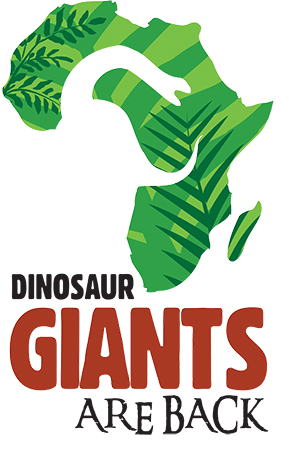
Dinosaur Giants in Elgin
May 24, 2017
May 15 - September 15, 2017
Dinosaur Giants are Back is the inspiring—and updated—story of the discovery of Africa’s Cretaceous-age dinosaurs by a Chicago paleontologist and his students. Set inside the beautiful spaces of the Gail Borden Library, the towering skeletons, real fossils, and expedition images and video will create a most attractive learning environment.
Dinosaur Giants are Back showcases groundbreaking discoveries that transport library visitors to a prehistoric world more than 100 million years old. It is based on its very popular forerunner in 2005, an exhibit fondly remembered by a generation of families from Elgin and well beyond.
The bizarre long-necked “Mesozoic cow” (Nigersaurus) is a centerpiece of the fully revamped and updated displays, on exhibit for the first time in the US.
270 N Grove Ave, Elgin, IL 60120
(847) 742-2411
Guided Tours |
|
Dinosaur Tours start May 22! Monday 3 pm, 7 pm |

Dinosaur Giants are back!
Science on Tap: Milwaukee Public Museum
February 5, 2016Milwaukee Public Museum, Milwaukee, Wisconsin
Follow the spectacular journey of an explorer who has discovered dinosaurs on five continents. Meet sail-backed meat-eaters, toothy fern-mowers, weird crocs and soaring pterosaurs, as Sereno paints a vivid picture of the extinct castaways he has unearthed on drifting continents. Now an update on the latest unveiled, “SuperJaws” aka Spinosaurus.
An evening social lecture series featuring some of the best minds in science and science reporting. We’re exploring the space where science and culture intersect, and we’re doing it over drinks. From quantum mechanics to the sensation of being hugged by an octopus, Science on Tap looks to answer questions you never knew you had about the natural world.
Time: 6 p.m. social hour; 7 p.m. lecture
Cost: $10, $5 for members.
Tickets: Call (414) 278-2728, visit MPM guest services, or purchase tickets online.
Cash bar available. Ticket includes general museum admission after 5 p.m. Recommended for ages 14+.
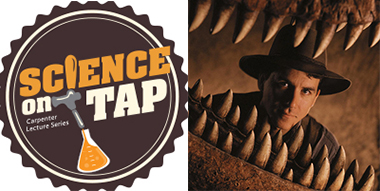
Tyler Keillor in the Wall Street Journal
March 25, 2015
CHICAGO—After careful consideration, Tyler Keillor made a decision: T. rex had lips. In the debate over dinosaurs’ “oral margin,” one of the country’s top paleoartists has taken sides. Mr. Keillor’s job is to create “flesh models” of dinosaurs and other prehistoric animals based on fossil evidence—giving creatures that died millions of years ago a face, a story and sometimes lips.
Using traditional mediums like clay and resin, as well as CT scanning and 3-D printing, he is at the forefront of incorporating digital art and technology into paleontology.
Continue reading (and watch the video!) on the Wall Street Journal: Did Dinosaurs Have Lips? Paleoartist Puts a Face on Ancient Bones.
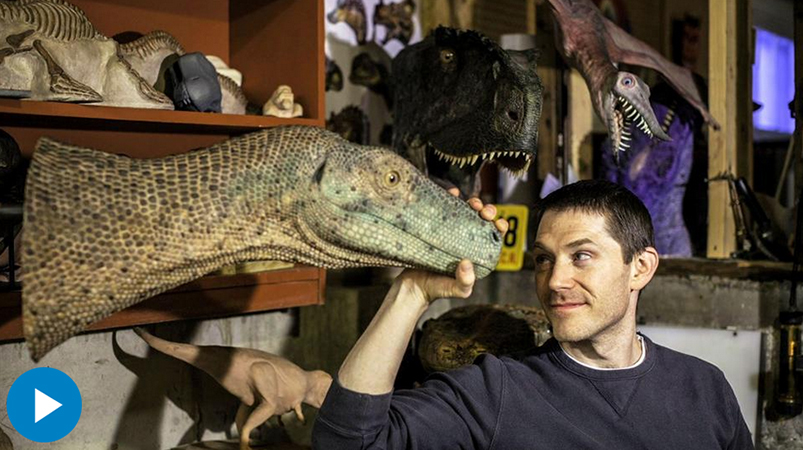
Tyler Keillor, a paleoartist at the University of Chicago, creates sculptures of dinosaurs and other prehistoric life. Photo: Bob Stefko for The Wall Street Journal
What’s New with Dinosaurs?
November 14, 2014
Radio Times with Guests: Peter Dodson, Ken Lacovara and Paul Sereno
Dreadnoughtus – the name alone should tell you a lot. Eighty-five feet long and 30 feet tall, this recently-discovered dinosaur was one of the largest land animals to ever walk the earth. And then there’s Spinosaurus – a new skeleton has revealed that this ferocious dinosaur with a crocodile-like snout spent a lot of its time in the water. In this hour of Radio Times, we get an update on these new discoveries and what they tell us about the ancient animals and their world. Our guests are KEN LACOVARA, the Drexel University professor who led the team that discovered and named Dreadnoughtus, PETER DODSON, professor of anatomy at the University of Pennsylvania and PAUL SERENO, professor at the University of Chicago. - See more at: http://whyy.org/cms/radiotimes/2014/11/12/whats-new-with-dinosaurs/#sthash.frKa7toJ.dpuf

Bigger than T.rex on PBS
November 3, 2014
The premiere broadcast of 'Bigger than T.rex' will air Wednesday November 5 at 9:00 pm CST on PBS.

Paul and Nizar on Chicago Tonight September 18 at 7:00 pm
September 17, 2014
Paul Sereno and Nizar Ibrahim will make an appearance on Chicago Tonight. Chicago tonight airs at 7:00 pm on WTTW (Channel 11).
Paleontologists Nizar Ibrahim and Paul Sereno are the scientists behind the discovery of Spinosaurus, the largest predatory dinosaur ever found. Described as "half duck, half crocodile," Spinosaurus is thought to have been semi-aquatic and its discovery is forcing experts to rethink what they thought they knew about dinosaurs.

Artwork by Davide Bonadonna
On Point: T-Rex and Montana’s Dinosaur Stories
June 10, 2014
CNN Interview on Massive Dinosaur found in Patagonia
June 10, 2014
Rare dinosaur tracks and other trace fossils from the Sahara described in new paper
March 7, 2014
University of Chicago paleontologists Nizar Ibrahim and Paul Sereno, in collaboration with an international team of researchers, have published a detailed account of trace fossils (records of biological activity in the fossil record, such as footprints and burrows) found in the Cretaceous Kem Kem region of Morocco. The track localities were first identified on a University of Chicago expedition in 1995, and revisited in 2008, and include prints of plant eating ornithopod dinosaurs and large sauropods. The vast majority of the tracks, however, can be attributed to theropods, predatory dinosaurs such as the T. rex sized Carcharodontosaurus. This mirrors the abundance of remains of predatory animals in the body fossil record (teeth, claws and other bones). The international team, which also included former Sereno lab member Jeff Wilson (now University of Michigan) as well as David Varricchio (University of Montana), Didier Dutheil (Paris), David Martill (University of Portsmouth) and Moroccan researchers Lahssen Baidder and Samir Zouhri (Casablanca University), also described many types of trace fossils left behind by invertebrate animals such as sea anemone, crabs and worms. The paper, based in part on PhD research carried out by Ibrahim, provides a detailed view of the animals and environments found on the coast of Northern Africa in the Cretaceous, when the region was a large river system that came under increasing marine influence.

Nizar Ibrahim taking notes on the escarpment where the tracks have been found.The Kem Kem region is located on the western edge of the Sahara Desert. Photograph by Robert Loveridge.
Dino Day at the Burke Museum
February 6, 2014
Special Lecture:
Unearthing Africa's Crocs, Dinosaurs & Ancient Civilizations with Dr. Paul Sereno
Friday, March 7, 7 pm
Kane Hall 130, UW Campus
Sail-backed meat-eaters, digging raptors, super-sized crocs, and pre-Egyptian numans are featured in this journey back in time with National Geographic Society Explorer-in-Residence and University of Chicago professor, Paul Sereno. Learnhow a lifetime of field research carried him to remote corners of the Sahara to discovery dozens of new species.
This lecture is FREE and open to the public. Registration reccommended: Click Here.
Sponsored by Nathan Myhrvold and Rosemarie Havranek.

Special Lecture with Dr. Paul Sereno 7:00 pm on March 7, 2014
Guest on wait wait… don’t tell me!
February 5, 2014
Since he's an expert on the dinosaurs of the past, we're going to ask him about a big, friendly dinosaur of the present. We'll present him with three questions about Barney, the purple dinosaur.Paleontologist Paul Sereno is a globe-trotting, headline-making explorer. He's a University of Chicago professor who has discovered several new dinosaur species — and he's also been named to People magazine's list of the 50 most beautiful people.

Paul Sereno was a guest on wait wait... don't tell me! with Faith Salie and Mo Rocca.
Dawn the Dinosaur moves to Comer Children’s Hospital
July 29, 2013
Dozens of children, physicians, staff and dinosaur enthusiasts gathered in the lobby of the University of Chicago Medicine Comer Children's Hospital on Oct. 14 to welcome Dawn the Dinosaur, a rare, museum-quality replica of the Herrerasaurus ischigualastensis discovered by the renowned University of Chicago paleontologist Paul Sereno. Dawn is a fitting name for this species of dinosaur, which was among the first to walk the planet, more than 230 million years ago. Sereno and a colleague unearthed the primitive carnivore in the Ischigualasto badlands of Argentina in 1988. It is the most complete fossil of the species discovered to date.
Dawn, now a permanent exhibit en route to the Children's Clinics at Comer, was donated by University of Chicago grad and longtime supporter Nicholas Pritzker. Pritzker's lifelong interest in paleontology peaked when his four children were young.
"They were fascinated by dinosaurs, so I did some digging into how to become a collector of fossils," said Pritzker. "My family has enjoyed this awe-inspiring piece of prehistory for many years. I'm thrilled that now children from across the city and around the world will find joy in her as well."
Sereno is equally proud to have one of his first, most-prized discoveries on display at Comer Children's Hospital and believes it will inspire future explorers.
"I hope that kids and their parents will stop by the display multiple times because there's a lot of information there," said Sereno. "I hope they will appreciate how much fun it was to discover that fossil and put together the story of Dawn the Dinosaur."

Dozens of children, physicians, staff and dinosaur enthusiasts gathered in the lobby of the University of Chicago Medicine Comer Children's Hospital on Oct. 14.